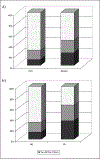Genotype-phenotype correlations for SLC26A4-related deafness
- PMID: 17690912
- PMCID: PMC10519375
- DOI: 10.1007/s00439-007-0415-2
Genotype-phenotype correlations for SLC26A4-related deafness
Abstract
Pendred syndrome (PS) and non-syndromic enlarged vestibular aqueduct (EVA) are two recessive disorders characterized by the association of sensorineural hearing loss (SNHL) with inner ear malformations that range from isolated EVA to Mondini Dysplasia, a complex malformation that includes a cochlear dysplasia and EVA. Mutations in the SLC26A4 gene, coding for the protein pendrin, have been implicated in the pathophysiology of both disorders. In order to determine whether SLC26A4 genotypes can be correlated to the complexity and severity of the phenotypes, we ascertained 1,506 deaf patients. Inner ear abnormalities were present in 474 patients (32%). Mutation screening of SLC26A4 detected two mutations in 16% of patients, one mutation in 19% of patients and zero mutation in 65% of patients. When the distribution of SLC26A4 genotypes was compared across phenotypes, a statistically significant difference was found between PS patients and non-syndromic EVA-Mondini patients (P = 0.005), as well as between EVA patients and Mondini patients (P = 0.0003). There was a correlation between phenotypic complexity of inner ear malformations and genetic heterogeneity--PS patients have the most severe phenotype and the most homogeneous etiology while EVA patients have the least severe phenotype and the most heterogeneous etiology. For all patients, variability in the degree of hearing loss is seen across genotypes implicating other genetic and/or environmental factors in the pathogenesis of the PS-Mondini-EVA disease spectrum.
Figures




References
-
- Abe S, Usami S, Hoover DM, Cohn E, Shinkawa H, Kimberling WJ (1999) Fluctuating sensorineural hearing loss associated with enlarged vestibular aqueduct maps to 7q31, the region containing the Pendred gene. Am J Med Genet 82: 322–8 - PubMed
-
- Albert S, Blons H, Jonard L, Feldmann D, Chauvin P, Loundon N, Sergent-Allaoui A, Houang M, Joannard A, Schmerber S, Delobel B, Leman J, Journel H, Catros H, Dollfus H, Eliot MM, David A, Calais C, Drouin-Garraud V, Obstoy MF, Tran Ba Huy P, Lacombe D, Duriez F, Francannet C, Bitoun P, Petit C, Garabedian EN, Couderc R, Marlin S, Denoyelle F (2006) SLC26A4 gene is frequently involved in nonsyndromic hearing impairment with enlarged vestibular aqueduct in Caucasian populations. Eur J Hum Genet 14: 773–9 - PubMed
-
- Azaiez H, Smith R (2007) In reference to temporal bone imaging in GJB2 Deafness. the laryngoscope 117 - PubMed
-
- Ballana E, Ventayol M, Rabionet R, Gasparini P, Estivill X (2007) Connexins and deafness Homepage. World wide web URL: http://davinci.crg.es/deafness/.
-
- Campbell C, Cucci RA, Prasad S, Green GE, Edeal JB, Galer CE, Karniski LP, Sheffield VC, Smith RJ (2001) Pendred syndrome, DFNB4, and PDS/SLC26A4 identification of eight novel mutations and possible genotype-phenotype correlations. Hum Mutat 17: 403–11 - PubMed
Publication types
MeSH terms
Substances
Grants and funding
LinkOut - more resources
Full Text Sources
Other Literature Sources

